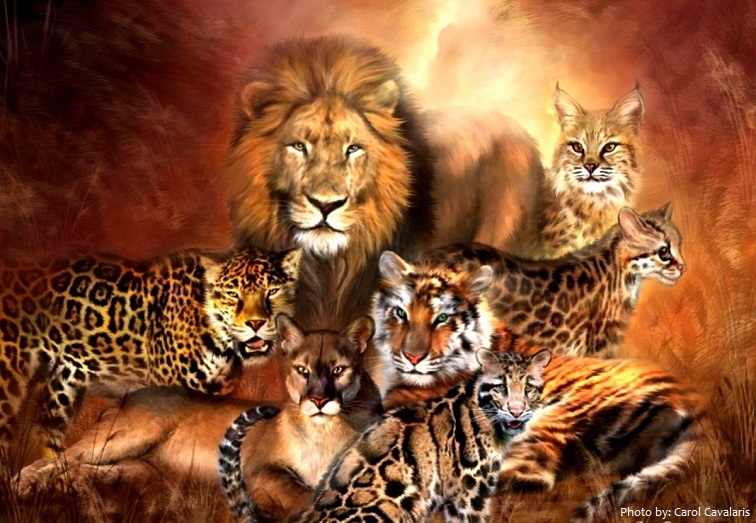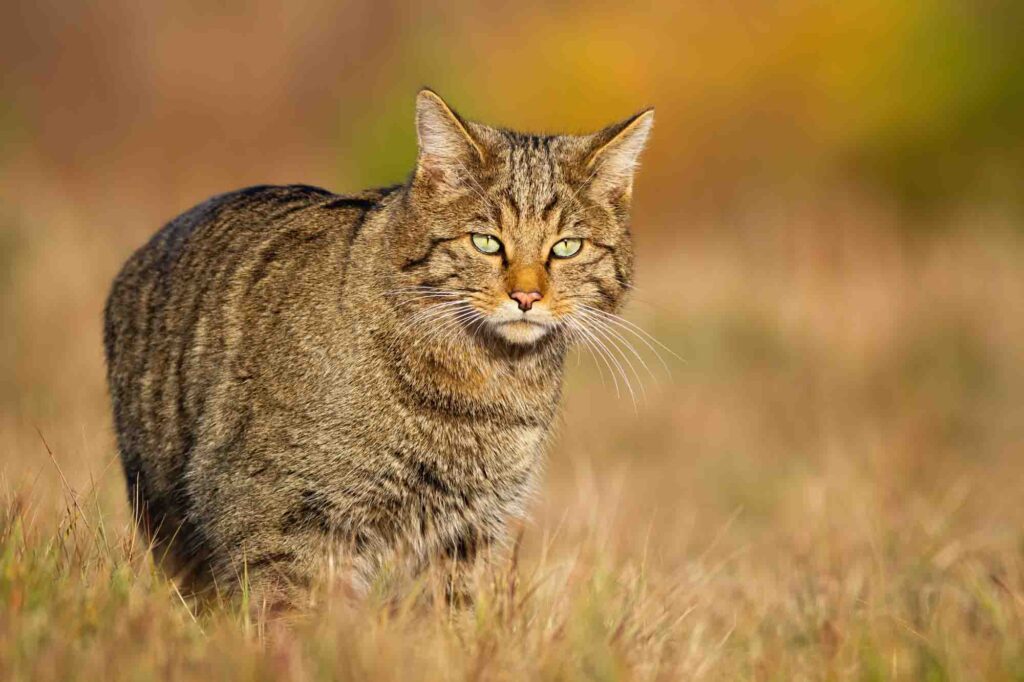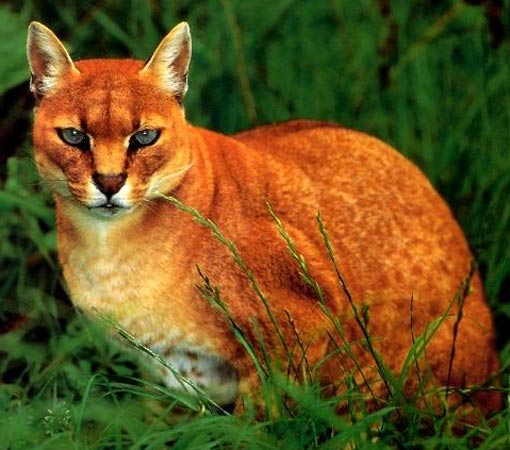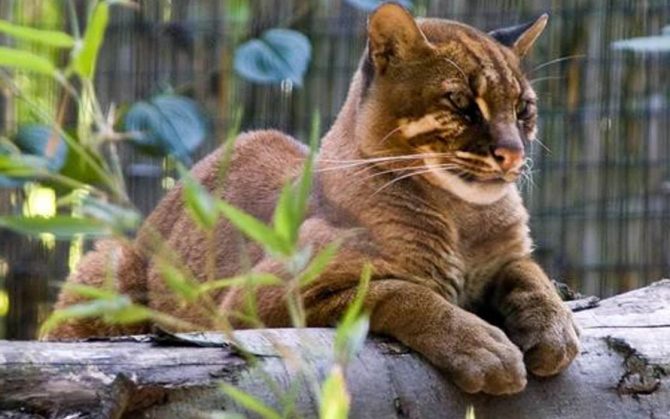11/ 28/2023 by Active Wild Admin
activewild.com
Jaguar
Subfamily: Pantherinae
Where found: South America
Conservation status: Near Threatened
The Jaguar is the largest cat found in the Americas, & the 3rd-largest species of cat in the world (only the tiger & lion are larger). It is a large, powerful apex predator, capable of preying on large animals such as caiman, green anacondas, & tapirs.
The jaguar has a golden-yellow coat, marked with black rosettes. Large males can weigh up to 96 kg (211 lb.).
The Jaguar is threatened by habitat fragmentation.
Jaguarundi
Scientific name: Herpailurus yagouaroundi
Subfamily: Felinae
Where found: South America; Central America
Conservation status: Least Concern
The jaguarundi is a small wild cat species native to the Americas. It has a slender, elongated body with short legs & a long, tapering tail.
The coat of the jaguarundi is variable in color, ranging from reddish-brown to grayish-black, with individuals sometimes appearing almost entirely black. The face is rounded with small, rounded ears, & large eyes.
These agile hunters are known for their adaptability, thriving in a variety of habitats, including forests, grasslands, & scrublands. Jaguarundis are primarily solitary & have a diet consisting of small mammals, birds, & insects.
Jaguarundis are occasionally seen as far north as Texas.
Jungle Cat
Other names: swamp cat; reed cat
Scientific name: Felis chaus
Subfamily: Felinae
Where found: Asia
Conservation status: Least Concern
The jungle cat is a mid-sized wild cat found throughout much of Asia. It has a pale, grey-brown unmarked coat & a faintly ringed tail. It stands around 40 cm (16 in) tall & weighs between 4–16 kg (9–35 lb.).
The jungle cat is associated with water, & is more likely to be found in swamps & wetlands with dense vegetation rather than rainforests.
A versatile predator, the jungle cat preys on a variety of small mammals, birds, & reptiles.
Kodkod
Alternative name: Guiña
Scientific name: Leopardus guigna
Subfamily: Felinae
Where found: South America
Conservation status: Vulnerable
The kodkod, or Guiña, is the smallest wild cat species of the Americas. With a maximum weight of just 2.5 kg (5.5 lb.), it is significantly smaller than a domestic cat.
The kodkod’s coat is gray-gold with black spots. Its thick tail is marked with black rings.
The species is found in temperate rainforests in Chile & parts of Argentina. Although a capable climber, it usually hunts on the forest floor. Rodents form the bulk of its diet, but it will also take a wide range of small vertebrates.
The Kodkod’s natural habitat has become severely fragmented & the species is further threatened by hunting.
Leopard
Scientific name: Panthera pardus
Subfamily: Pantherinae
Where found: Africa; Asia
Conservation status: Vulnerable
The Leopard is a species of big cat found in sub-Saharan Africa, Asia, & parts of Russia. It is similar in appearance to the Jaguar but slightly smaller & less bulky. Its pale golden coat is covered in distinctive rosettes which, unlike those of the Jaguar, are not filled with spots.
The leopard is known for its strength, & will carry a kill up a tree to prevent it being stolen by hyenas.
Leopard Cat
Scientific name: Prionailurus bengalensis
Subfamily: Felinae
Where found: Asia
Conservation status: Least Concern
The leopard cat is a small wild cat that is widely distributed throughout Asia. Countries in which it is found include China, Russia, India, & the Philippines.
The species is found in a range of forest habitats, including rainforests & temperate broadleaf forests. It is also found in grasslands, but usually prefers those with some tree cover. It feeds mainly on mice, rats, & other small vertebrates.
The leopard cat is similar in size to a domestic cat. The patchy spots that cover its body give it the appearance of a miniature leopard, hence the species’ name. The color of its coat ranges from gold to grey, depending on where it is found.
The Iriomote cat is a subspecies of leopard cat that is endemic to the Japanese island of Iriomote. It is found in forests & mangroves.
Lion
Scientific name: Panthera leo
Subfamily: Pantherinae
Where found: Africa; Asia
Conservation status: Vulnerable
One of the best-known types of wild cats, the lion is the world’s second-largest cat species; only the tiger is bigger.
The lion is the only truly social cat. Unlike other wild cats, which are typically solitary, lions live in groups known as "prides".
Lions are large, muscular wild cats with a distinctive tawny-colored coat, which in some individuals may be slightly darker or lighter. Lions are known for their majestic mane of the male, which can range from blond to dark brown.
Lions are found in eastern & southern Africa, and in 2 very small, isolated groups in India. They are threatened by indiscriminate killing by local people (often because of the lion’s perceived threat to livestock), who leave poisoned carcasses for the lions to eat. Lions are also hunted for their body parts, which are used in traditional Asian medicine.
Marbled Cat
Scientific name: Pardofelis marmorata
Subfamily: Felinae
Where found: Asia
Conservation status: Near Threatened
Similar in size to a domestic cat, the marbled cat is closely related to the Asian golden cat & the bay cat. The species is found in southern & southeastern Asia.
The marbled cat is brown-red in color with darker, cloud-like blotches. Its tail is as long again as its head & body. The long tail helps the cat to maintain its balance while climbing.
The species prefers pristine forest, & is threatened both by habitat loss & hunting. Its population is severely fragmented.
Margay
Scientific name: Leopardus wiedii
Subfamily: Felinae
Where found: South America; Central America
Conservation status: Near Threatened
The margay is a small south American type of wild cat. It is found in several countries in south & central America, including Brazil, Peru, & Mexico.
With a pale-yellow coat & numerous black spots, the margay is similar in appearance to its close relative the ocelot, but is smaller, being similar in size to a domestic cat.
An excellent climber, the margay often rests in trees. However, it does most of its hunting on the ground.
Threats to the margay include habitat loss, illegal hunting for its skin, & capture for the pet trade.
Mountain Lion
Alternative names: puma, cougar, catamount
Scientific name: Puma concolor
Subfamily: Felinae
Where found: North America; South America
Conservation status: Least Concern
The mountain lion is a large wild cat found in both North & South America. The species is also commonly known as both the puma & the cougar.
The species’ large range stretches from northern Canada to the Andes in South America. It is found in a wide range of habitats, including forests, grasslands, & deserts.
The mountain lion is the second-largest cat of the Americas (the Jaguar is the largest), & the 4th-largest of all cat species. Despite being (on average) larger than a leopard, the mountain lion is not considered to be a big cat, as it cannot roar.
The species is a stealthy ambush predator whose favored prey is deer. It will also prey on livestock.
Ocelot
Scientific name: Leopardus pardalis
Subfamily: Felinae
Where found: South America; Central America
Conservation status: Least Concern
The ocelot is a striking, medium-sized wild cat found in south & central America. The species is occasionally sighted as far north as southern Texas. It inhabits various habitats, from dense rainforests to arid grasslands.
Around twice the size of a domestic cat, the ocelot has a slender, graceful body with a distinctive coat pattern, featuring a background of tawny or yellowish fur adorned with black rosettes & spots.
The ocelot is primarily nocturnal, preying on small mammals, birds, & reptiles.
Oncilla
Alternative names: northern tiger cat; little spotted cat; tigrillo
Scientific name: Leopardus tigrinus
Subfamily: Felinae
Where found: South America
Conservation status: Vulnerable
The oncilla, also known as the little spotted cat or tigrillo, is a small wild cat species native to Central 7 South America, closely related to the ocelot & margay. It possesses a petite, slender body with a dappled coat of rich tawny or grayish-brown fur adorned with distinctive dark spots & rosettes. The oncilla has large, expressive eyes, rounded ears, & a short tail with a dark rings.
These elusive & solitary hunters are mainly nocturnal, preying on small mammals, birds, & insects. Their elusive nature & cryptic appearance make them challenging to spot in their preferred habitats, which range from tropical rainforests to montane forests.
Pallas’s Cat
Alternative name: Manul
Scientific name: Otocolobus manul
Subfamily: Felinae
Where found: Central Asia
Conservation status: Least Concern
Known for its distinctive appearance, Pallas's cat has a stocky body, short legs, & a flat, rounded face. Its fur is dense & covers a range of colors, from pale gray to yellowish-brown, marked by irregular dark spots & stripes, giving it a unique, almost comical appearance. Its ears are positioned low on the sides of its head, allowing it to keep a low profile when stalking its prey.
This Asian wild cat is similar in size to a domestic cat, weighing between 2.2 & 4.1 kg (5 & 9 lb.).
Pallas's cats are highly adapted to their harsh, cold environments & are skilled hunters, primarily preying on small mammals and birds. These solitary & elusive cats are well-suited to the challenging terrain of their high-altitude habitats.
Pampas Cat
Alternative names: Pantanal cat; Colocolo
Scientific name: Leopardus colocolo
Subfamily: Felinae
Where found: South America
Conservation status: Near Threatened
The pampas cat is a small wild cat species native to South America, particularly the grasslands & shrublands known as the pampas. It is present in Ecuador, Peru, Brazil, Bolivia, Chile, Paraguay, Uruguay, & Argentina.
The species has a slender, agile body with a coat that ranges from pale orange to silver-grey, adorned with subtle dark spots & stripes. Its face is round & it has distinctive ear tufts. The tail is short & often banded with dark rings. Most pampas cats weigh under 4 kg (8.8 lb.); less than a domestic cat.
These solitary & nocturnal hunters prey on small mammals, birds, & insects. They are expertly adapted to their grassland habitats & can be elusive.
Rusty-Spotted Cat
Scientific name: Prionailurus rubiginosus
Subfamily: Felinae
Where found: Indian Subcontinent; Sri Lanka
Conservation status: Near Threatened
The rusty-spotted cat is the world's smallest wild cat species, weighing between 0.9 & 1.6 kg (2.0 & 3.5 lb.), & reaching a maximum head-body length of 48 cm (19 in). A large tiger (the biggest wild cat species) is 200 times bigger than a rusty-spotted cat!
Native to India & Sri Lanka, this diminutive felid is characterized by a tiny, slender body, short legs, & a coat with a reddish-brown hue & distinctive rusty spots & stripes.
Rusty-spotted cats have round faces, large eyes, & a short tail marked with bands & a dark tip. These elusive & primarily nocturnal hunters feed mainly on small rodents. They thrive in a variety of habitats, from forests to grasslands, & their small size allows them to navigate the dense underbrush effectively.
Sand Cat
Scientific name: Felis margarita
Subfamily: Felinae
Where found: Asia; North Africa
Conservation status: Least Concern
The sand cat is a desert specialist that lives in arid regions of north Africa & southwest & central Asia.
Smaller than a domestic cat, the sand cat is a pale sandy color, with 2 distinctive black bands around its front legs & dark bands spreading outwards from its eyes.
The paws of the sand cat are covered in thick, stiff fur, allowing the cat to walk over hot sand. The species can obtain all of the water it needs from its prey, which consists mainly of small rodents. (It will also drink from a water source if one is available.) The sand cat is a fast digger, & will burrow into the sand in order to reach its prey.
The sand cat is mainly active at night. During the day, it shelters from the harsh desert sun in burrows or among rocks.
Serval
Scientific name: Leptailurus serval
Subfamily: Felinae
Where found: Africa
Conservation status: Least Concern
The serval is a mid-sized African species of wild cat. It is found mainly in Sub-Saharan Africa, where it inhabits a variety of habitats, but is absent from rainforests & deserts.
The serval’s coat is a pale sandy color & covered in large black spots, some of which merge into lines. For its size, the serval has the longest legs of all cats. Other distinguishing features include a small head & extremely large ears.
The serval preys mainly on small vertebrates such as rodents, but will also take animals as large as small antelopes.
The Serval has a wide range & is relatively common.
Snow Leopard
Alternative name: Ounce
Scientific name: Panthera uncia
Subfamily: Pantherinae
Where found: Asia
Conservation status: Vulnerable
Despite its name, the snow leopard is more closely related to the tiger than the leopard.
This graceful & elusive wild cat is found in the mountains of central & south Asia. The regions in which it lives are covered in snow for at least part of the year.
The snow leopard has a pale yellow-white coat marked with dark rosettes. Its eyes are pale green / grey. The species' long, thick fur retains heat, & its large feet enable it to walk over snow without sinking.
It is estimated that there are fewer than 3,500 adult snow leopards in the wild. Threats to the species include habitat loss & hunting.
Southern Tiger Cat
Alternative name: Southern tigrina
Scientific name: Leopardus guttulus
Subfamily: Felinae
Where found: South America
Conservation status: Vulnerable
The southern tiger cat is a small wild cat found in Brazil, eastern Paraguay, & northern Argentina. Until recently (2013), it was considered to be a subspecies of oncilla.
The southern tiger cat has a yellow-brown coat marked with rosettes. It inhabits a range of habitats, including rainforests & savannas.
Sunda Clouded Leopard
Scientific name: Neofelis diardi
Subfamily: Pantherinae
Where found: Borneo; Sumatra; Other Southeast Asian islands
Conservation status: Vulnerable
The Sunda clouded leopard was identified as being a separate species to the clouded leopard in 2006. The species is native to the Southeast Asian islands Sumatra & Borneo.
This elusive wild cat has a medium-sized, muscular body with a striking coat pattern consisting of large, cloud-like spots & rosettes on a golden-yellow to grayish background. This distinctive coat helps the Sunda clouded leopard blend seamlessly into the dense rainforests it inhabits.
Sunda clouded leopards are known for their large canines relative to their size. They are primarily solitary & nocturnal hunters, preying on various small to medium-sized mammals & birds. Their secretive nature & cryptic appearance make them a captivating & rarely seen species in their natural habitat.
There are around 4,500 Sunda clouded leopards of breeding age in the wild, a figure thought to be decreasing. The decline is due mainly to deforestation caused by logging & the conversion of forests into oil palm plantations.
Sunda Leopard Cat
Scientific name: Prionailurus javanensis
Subfamily: Felinae
Where found: Southeast Asia
Conservation status: Unassessed
The Sunda leopard cat is a small wild cat found on several Southeast Asian islands, including Borneo, Sumatra, & Java. Until recently, it was considered a subspecies of the leopard cat found in mainland Asia.
The Sunda leopard cat has long legs & a slender body. Its fur is orange-brown with black spots, patches & lines. It inhabits a variety of forests, & may also be found in grasslands. It preys mainly on rodents.
Tiger
Scientific name: Panthera tigris
Subfamily: Pantherinae
Where found: Asia
Conservation status: Endangered
The tiger is the largest species of cat in the world. Large males can reach weights of over 350 kg / 770 lb. & have total body-tail lengths of 3.9m / 12.8 ft.
The tiger has a fragmented population across Asia, & is found in habitats as diverse as snow-covered Siberian forests & tropical mangrove swamps.
Despite the tiger being one of the world’s most recognizable animals, it is an endangered species. Only around 3,000 tigers of breeding age are left in the wild; there are currently more tigers in captivity than there are in the wild.
Biologists disagree over the number of tiger subspecies; recent research has identified just 2 subspecies: a mainland subspecies, & one found on the Greater Sunda Islands.
Other biologists believe that up to 9 tiger subspecies exist, including well-known subspecies such as the Siberian Tiger & the Bengal Tiger.
Cute Critter Pics:
Weekly Chuckle:


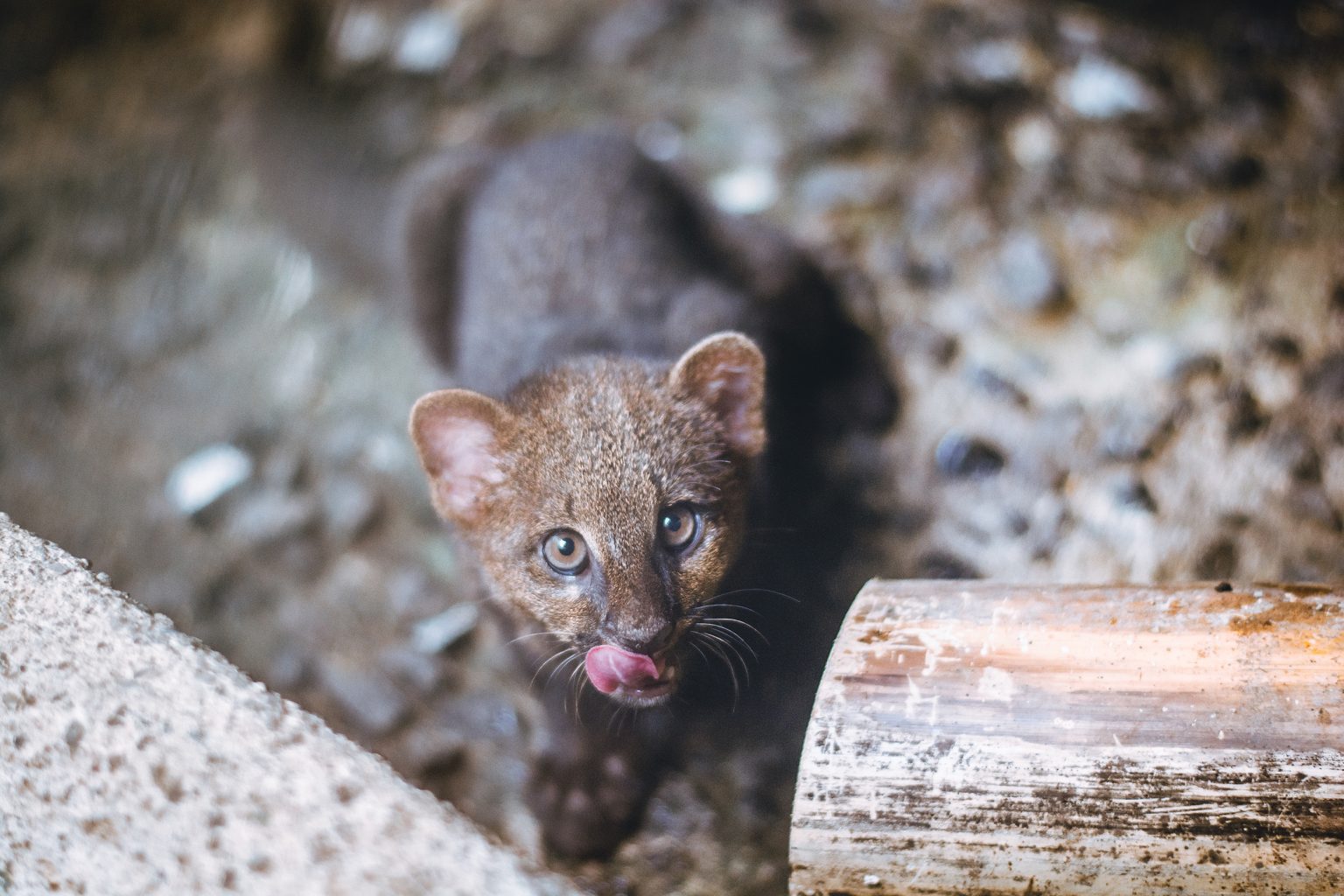





:max_bytes(150000):strip_icc()/__opt__aboutcom__coeus__resources__content_migration__mnn__images__2015__09__11724185476_a1a6c1c2f7_k-6470f0c31d6941fb854f97acc903a421.jpg)








